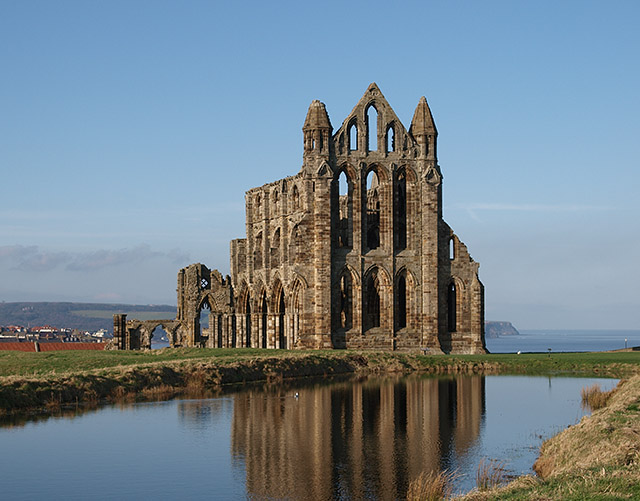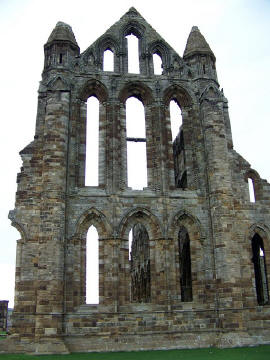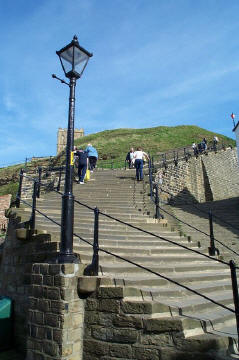Whitby Abbey
Whitby, Yorkshire
|

Featured Location Guide |
Whitby Abbey is an historically important site
that once housed a Celtic monastery later to become a double Benedictine
monastery, having both nuns and monks. It has a place in history in relation
to the change over from Celtic Christianity to the Roman Catholic faith and
has inspired several others including the author of Dracula.

Whitby Abbey and Fishpond
 Stephen McCulloch
Stephen McCulloch

For the photographer this high setting over
Whitby harbour, headland setting, views, a nearby pond near the abbey and other opportunities will appear.
Very little of the abbey beyond the abbey
church remains, although the remains are substantial, and used for ship
navigation.
|
It is said to be founded in 657, by the
Anglo-Saxon King of Northumbria, Oswy (Oswiu) as Streoneshalh, it was much
later renamed to Whitby, his niece St Hilda, a princess of the Northumbrian
royal house, whose Saxon name Hild means 'battle' was the founding Abbess,
she was already the Abbess of Hartlepool Abbey. Recent archaeological
research undertaken by English Heritage suggests that it was once a bustling
settlement, as well as the burial place of the Northumbrian Royal family,
the setting of an epoch-making international meeting between Celtic and
Roman clerics, and the home of saints such as the poet Caedmon.
In 664, the abbey was the site of the
'Synod of Whitby', at which King Oswiu ruled that the Northumbrian Church
would adopt the Roman calculation of Easter and monastic tonsure. Moving
from the Celtic to Catholic form of Christianity. Up to this point the
king and his predecessors had been part of the Celtic church but his
wife came from a family that were a part of the catholic faith, and
particularly celebrating Easter and other related events at different
dates was difficult.
While there was a change over at a range of
dates in different kingdoms across Britain going from the Celtic to Catholic
format, this is seen as a major event as this involved the pulling
together of different faiths. For the Celtic church this seemed minor,
different dating calculations and a different way to cut their hair, and
they gave in, it later is said to have resulted in the fading out of the
earlier Celtic Christian form from general use. The Pope later decreed that
those baptised to simply as Christians were not Christians, and that they
had to all be baptised again in the name of the three, God, Son and Holy
Ghost, which of course meant that all other pre existing bishops and priests
ware non Christians and could be replaced by Catholics, a useful way to
remove all who objected in any way to aspects of the roman religion as it
swamped earlier Christianity.
The Abbey fell to the Vikings in 867 and was
destroyed or abandoned.
Later in 1078 is was a refounded and rebuilt
and dedicated to St Peter and St Hilda by Regenfrith (Reinferd) a soldier
monk, on the orders of the Norman, William de Percy.
The name changed several times, it became
Presteby (meaning the habitation of Priests in Old Norse) then Hwytby; next
Whiteby, (meaning the "white settlement" in Old Norse, probably from the
colour of the houses) and finally Whitby. From this we can see that the
concept of the 'Synod of Whitby' may be questionable as Whitby did not exist
at this earlier time, and possible that its a case of re-written history.
|
 
East Facade
 Trish Steel
Trish Steel

  Whitby 99 Steps
 Derek Dye
Derek Dye
 |
The second monastery survived until the
dissolution of the monasteries by Henry VIII and was destroyed in 1540. It then
was abandoned and used as a source of stone. It was left mainly intact as it
was and still is used by shipping for navigation purposes. The site then
passed to the Cholmley family, who built a mansion largely out of materials
plundered from the monastery.
A visitor centre now sits within the walls of
the Cholmley family mansion, part of a major interpretation and access project
encompassing the whole of the headland, hailed as one of the most important
archaeological sites in England. One of the aims of the project has been to
enhance and protect the natural beauty and historic character of this headland.
English Heritage's research excavations have added to our understanding of
Whitby's complex history, including the discovery of a rare 17th Century 'hard
garden', inspired by Cholmley's visits to France and Spain and now restored.
Continuing research may yield further insights into this multi-layered site.
The visitor centre houses archaeological material excavated at Whitby, as well
as computer generated images revealing how the headland has changed over time.
Rich finds from the Anglo-Saxon and medieval periods are also exhibited,
together with objects relating to the Cholmley family. Spectacular audio-visual
displays recreate the medieval abbey and the 17th-century house, its interiors
and gardens. Visitors can also gain an insight into the people who have been
inspired by the Abbey, from St Hilda to Bram Stoker, author of Dracula.
 Click on the
smaller images to see larger versions Click on the
smaller images to see larger versions
| Further information Grid
|
Location: |
Whitby Abbey, Whitby, Yorkshire |
|
Ceremonial County: |
Yorkshire
 |
|
Grid Reference: |
NZ903112 |
|
Map Link: |
StreetMap
 |
|
Aerial photo: |
Google Aerial
 |
|
Route(s):
|
|
|
Best Times to Visit: |
|
|
E-mail: |
|
|
Website: |
EH
 |
|
Other useful
websites: |
Wiki  |
|
Nearby Locations: |
Whitby
Lighthouse, Yorkshire 
 |
|
Other Relevant pages: |
Abbey
Section,
 including all major Christian buildings, regions orders, normal layouts and
history.
including all major Christian buildings, regions orders, normal layouts and
history. |
|
|
.
Planning Grid
|
Location: |
Whitby Abbey, Whitby, Yorkshire |
|
Grid Reference: |
NZ903112 |
|
Getting there: |
On cliff top, E of Whitby. Road access from
town centre via Bridge Street, left into Church Street and the right into
Church Lane which feeds straight into Abbey Lane by the ruins. |
|
Access: |
From the Whitby harbour area, the abbey can
only be directly reached on foot via the 199 'abbey steps' (or Caedmon's
Trod), but you can also get there by road by taking a longer route around by
car, see above. |
|
Parking: |
Parking in main car park is chargeable. |
|
Facilities: |
Toilets, Picnic Area, Shop |
|
Things To Do,
See and Photograph: |
Buildings, architecture, views particularly of
the town below and coastal. |
|
What to take: |
Tripod, level, wide angle lens. |
|
Nature highlights: |
Aylesbury Abbey Ducks |
|
Address: |
Abbey Lane
Whitby
North Yorkshire |
|
Postcode: |
YO22 4JT |
|
Telephone: |
|
|
Opening times: |
1 Apr-30 Sep 10am-6pm Daily
1 Oct-24 Oct 10am-4pm Thu-Mon 25 Oct-31
Oct Daily
1 Nov-31 Mar 10am-4pm Thu-Mon
Closed 24-26 Dec and 1 Jan |
|
Charges: |
English Heritage: Free to members
Adults £6, Children £3.60, Concessions £5.40; Family £15.60 |
|
Photo Restrictions: |
|
|
Other Restrictions: |
|
|
Special Needs Access: |
Access to grounds via lift from visitors
centre. Grass paths around ruins. Ramped entrance to site. |
|
Special Needs Facilities: |
Toilets in car park |
|
Children Facilities: |
|
|
Dogs Allowed: |
On leads in restricted areas only |
|

|
Please let us know any other information that we
can add to the Further information and Planning Grids or page and any errors that you discover. Before making a long trip to any location it is always
wise to double check the current information, websites like magazines may be
correct at the time the information is written, but things change and it is of
course impossible to double check all entries on a regular basis. If you have
any good photographs that you feel would improve the illustration of this page
then please let us have copies. In referring to this page it is helpful if you
quote both the Page Ref and Topic or Section references from the Grid below. To print the
planning grid select it then right click and print the selected area.
Please submit information on locations you discover so
that this system continues to grow.
|